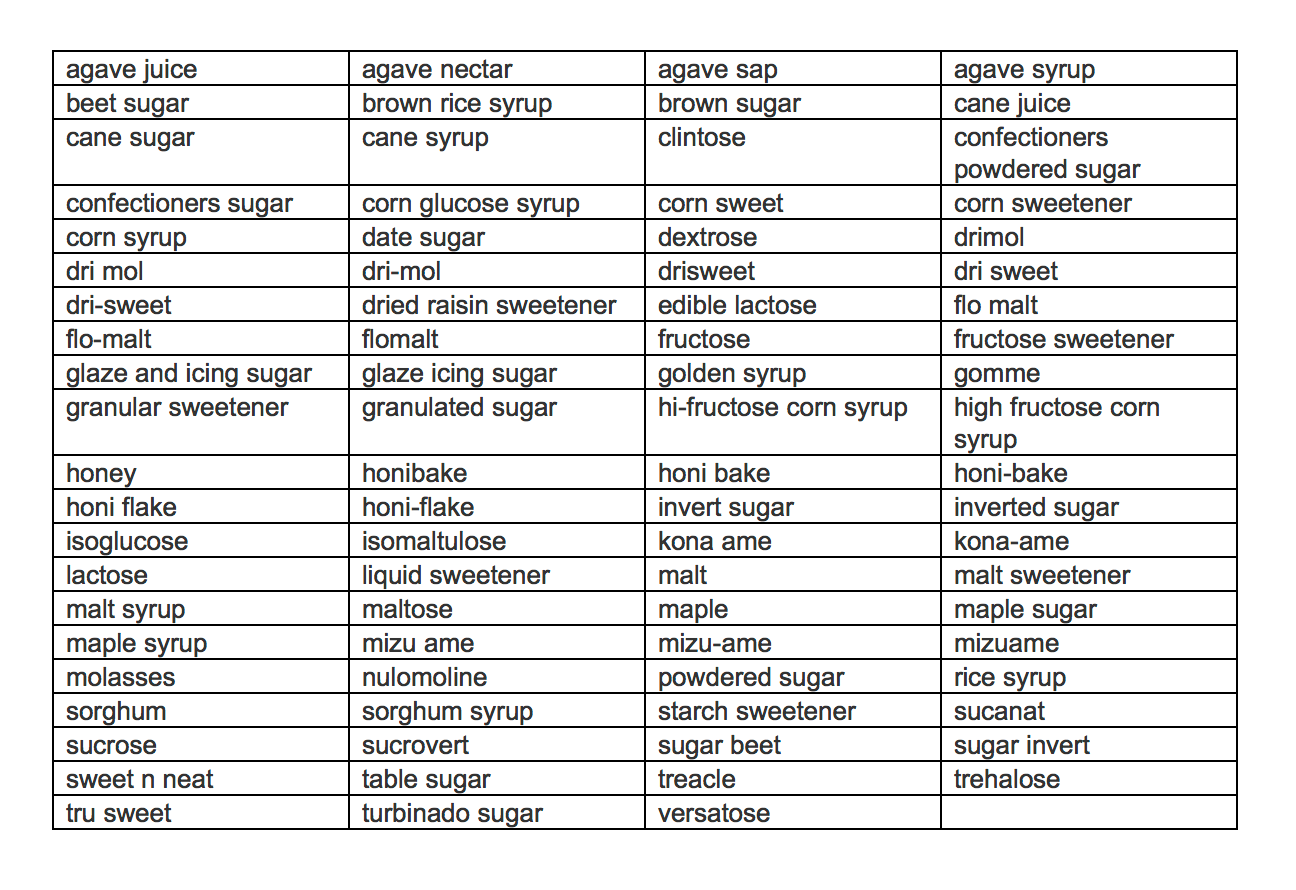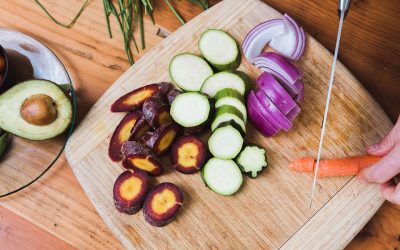With the viewership success of my September 2017 TEDx talk, Sugar is Not a Treat, hitting over 2,000,000 views as of February 2021, I’m writing this article to expand on a few things I did not have time to mention, as well as share about my experience preparing for and presenting this talk. (Be sure to read to the end to reach this entertaining section.)
As the title clearly states, sugar is not a treat. The fact that consuming excessive amounts of added sugars is harmful to the body should not be a surprise to anyone. Unfortunately, sugar is hiding in many of today’s most common foods — meaning not only in obvious processed junk foods, but also in many common foods, as well as even ones labeled as ‘healthy.’ Code words for sugar that are often seen in ingredients lists include:
- Agave
- Coconut Sugar
- Brown Sugar
- Fruit Juice Concentrates
- Honey
- Malt Syrup
- Maple Syrup
- Molasses
- Raw Sugar
- Fructose
Do not be fooled. These all mean: sugar.
There are only 10 large food corporations today that control the majority of our world’s food supply, and the more sugar a food contains, the more it sells. That’s why there are so many sneaky words used to mask the massive amounts of sugar hiding in the incredibly long ingredients lists.
A point I wanted to clarify from the talk was that the sugar I am referring to is “added-sugar.” I was not referring to the naturally occurring sugars found in whole foods grown in nature. There are only four categories of these nature-made carbohydrates:
- Fruit
- Vegetables
- Whole Grains
- Legumes
These foods, when consumed in their whole-food form, are an integral part of a healthy diet.
How Our Bodies Process Sugar
In my TEDx talk, I talk about one of the most vital organs we cannot live without — the pancreas.
Inside the pancreas, resides a small cluster of cells called beta cells. You only have a total of two grams of beta cells, and two grams is equivalent to the size of just two almonds. If these life-saving cells were to wither away, in the absence of medical intervention, you would die within a few weeks.
Anytime you eat sugar, or highly refined carbohydrates, the sugar circulates in your blood stream all throughout your body. The beta cells are the “security guards” for your blood. As soon as they see this rush of sugar, they sound the alarm bells off to call in a team of “dump trucks” to remove the sugar from your body. The dump trucks are called insulin. The insulin takes the excess sugar out of the blood and feeds it to your liver, muscles, or stores it as fat.
Today, millions of people are overworking their security force. Overworking your beta cells can not only happen with obvious foods like cake and ice cream, but also with refined carbohydrate foods like:
- Yogurt
- Granola
- Cereal
- Bread
- Pasta & Pasta Sauce
- Salad Dressing
- Soda & Energy Drinks
- Alcohol — even when used in moderation.
Anytime you eat highly processed foods, your beta cells sound off the alarm to — “make more insulin!” This should be of concern because just like anything that is overused, like cars to computers, parts can eventually wear out — leading to beta cell burnout.
Beta Cell Burnout
Beta cell burnout is also known as pre-diabetes or type 2 diabetes. It can happen to anyone and has a lot to do with food choices. As beta cells weaken over time, the blood sugar levels can rise to a dangerous level. When beta cells get really weak, without a change in diet, insulin injections will likely be needed — everyday — for the rest of your life to stay alive.
Reversing beta cell burnout in pre-diabetes and type 2 diabetes is possible, especially when caught early, through dietary and lifestyle changes.
Type 1 Diabetes & Beta Cells
In type 1 diabetes, the immune system attacks and kills the beta cells in the pancreas. As a result, without beta cells, type 1’s need to inject insulin, or administer it via a pump, every single day of their lives. Having lived with type 1 diabetes since the age of seven, I’ve personally taken over a hundred thousand insulin shots in my lifetime — thus far.
Living with type 1 diabetes, in a way, has been a gift though because I’m so motivated to NOT eat sugar, which is why I’m so vibrant after 35+ years of living with diabetes. When I eat sugar, my blood sugar skyrockets and I immediately get a headache, feel cranky and want to take a nap.
Most people are oblivious to this direct correlation between what they ate and how they feel. The negative effects of sugar on anyone living WITHOUT type 1 diabetes are far more subtle, but potentially just as deadly.
Health Risks of Sugar Consumption
After consuming sugar, you may feel an immediate rush of energy, but what goes up — must come down. Next time you eat a candy bar, pay attention to how you feel an hour or two later. You’ll likely crave more sugar, feel a bit zapped, hungry, cranky or you may just want to take a nap.
If this continues over a lifetime, the beta cells get weak, the blood sugar levels rise, and over time, chronically elevated blood sugar can lead to:
- Heart Disease
- Kidney Failure
- Stroke
- Gangrene
- Blindness
- Alzheimer’s
- Lower Limb Amputation
- Depression
- Violent Behavior
- And more…
The number of deaths caused by sugar — all of these afflictions combined — leads to more deaths than automobile accidents.
Benefits of Removing Refined Sugars
According to the World Health Organization, there are over 420 million people today with type 2 diabetes. In America alone, if our eating habits do not change, statistics show that 1 in 3 people will have type 2. That means, it will likely be someone you know and love. Or, it might be you.
It’s easy to fall into the traps set by the 1.5 trillion dollar processed food industry, but with a little self-discipline and dedication for a healthier you, it can be done. Eliminating refined sugars doesn’t have to be overwhelming.
People with blood sugar issues should use natural sources of carbohydrates in moderation. I personally like to keep my carb count to under 25 grams at any one time and I rarely eat grains. Furthermore, all fruits and vegetables do not affect blood sugar the same. Lower glycemic fruits and vegetables are preferred for anyone with blood sugar issues, such as apples, cherries and berries versus higher glycemic choices such as pineapple, watermelon and dates. I do not recommend fruit juice of any kind, especially when most commercial brands typically contain less than 10 percent real fruit.
In my TEDx talk, I recommended that a healthy diet should consist of at least 80 percent healthy, whole foods, which allows for occasional favored treats 20 percent or less of the time. Because this talk is shared with the masses, and frankly the average diet today is more like 80 precent processed and maybe 20 percent healthy, I proposed the 80/20 ratio because it’s a more realistic goal for most people to achieve.
I did not have time to talk about the benefits of organic, virtues of vegetarianism or veganism. The goal of my talk was not to advocate a certain way of eating that will be interpreted as extreme by most people, although I personally buy organic and primarily eat vegetarian. My intention was simply to encourage the masses to eat less added sugar.
Take a look at these immediate benefits to you of eating less sugar:
- More Energy
- Better Skin
- Less Anxiety
- Better Memory
- More Productivity
- Better Sleep
- More Joy
Reducing sugar and highly processed carbohydrates from your diet could change your life. I see it every day with patients I’ve helped all around the world. When making a big change in life, all you need to do is start small.
Here are three steps you can start today:
- Have protein for breakfast. Starting your day with foods that keep your blood sugar levels stable will give you more energy throughout your day.
- Craving a snack? Try water first. Dehydration can feel like hunger. A 5 percent decrease in hydration can correlate to a 20 percent decrease in energy.
- Find low sugar replacements for high-carb foods. Try cauliflower pizza crust, zucchini noodle pasta or chocolate chip cookies made with almond flour using stevia as a sweetener (which comes from a plant and does not impact blood sugar levels). Search online and you’ll find hundreds more low-carb alternative recipes!
Cutting back on sugar and protecting your precious beta cells could be life changing for you. You have the knowledge. And you have the power.
When you cut back on sugar every day, you will also be using your meals as they were intended ….to fuel you into greatness.
Alternative Sweeteners
I’ve received many questions about acceptable and safe alternative sweeteners. In my talk, I only mentioned Stevia, which has no effect on blood sugar. Other safe sweeteners include:
- Xylitol
- Erythritol
- Monk Fruit
I do NOT recommend:
- Splenda/Sucralose — found to inhibit zinc and iodine absorption as well as decrease healthy gut flora
- Equal/Aspartame — linked to increased rates of cancer, seizures, weight gain and more
- SweetNLow — linked to increased rates of some cancers
- Sorbitol and Maltitol — can raise blood sugar and cause GI issues
Negative Impacts of Sugar on the Body
To learn more about type 1 diabetes versus type 2 diabetes, as well as what to do about them from a holistic lifestyle management point of view…
Check out my radio interview with Dr. Tyna Moore — Click here.
Words That Really Just Mean ‘Added Sugar’

My TEDx Experience
Having presented to live audiences all throughout my career, I figured speaking to a TEDx crowd would be no different. How wrong I was.
The TED audience is vast, so the topic should ideally appeal to the masses. My first draft went into great detail about beta cells. I thought it was brilliant. My amazing speaking coach, Judy Winslow, did not agree.
The number of red lines through my first draft hit me like a brick. I wanted to tell Judy how wrong she was, but I acquiesced and wrote a second, less scientific draft. Again, she didn’t like it. I wrote a third draft. More red lines. Then a fourth, a fifth, a sixth…
Judy and I spoke weekly over a two month period and I vividly remember the day I wanted to give up. I told Judy that since everything I wanted to write had been rejected, I had nothing left to say. I considered calling the TEDx team to announce that I was no longer available to present. Luckily, I pulled through.
Judy challenged me to think bigger and dig deeper. I transformed my talk from beta cells, a topic I care deeply, into something people are really starting to pay attention to: Sugar. Days later, the title was born: Sugar is Not a Treat.
My desire to make edits continued, which was problematic, because the talk had to be memorized. The TED presentation style is unique in that each speaker must fit everything into a maximum of eighteen minutes with no notes. Since it had been several years since I memorized anything, I was taken aback by how hard this part was.
During the practice run on stage the day prior, I froze. The lights were blinding. Just as my vision was blocked, so was my mind. I stumbled on words, forgot huge sections and couldn’t remember my closing statement. I went home that night with more fear than I had felt in ages.
Luckily I was soon quickly reminded of what I’ve learned about myself in the past: I come alive with a live audience. When it was time for the real deal, I nailed it!
Having said that, a few bloopers still snuck in…
My TEDx Talk Bloopers
As you can imagine, the pressures of standing on stage at a TEDx conference is a bit daunting. As a result, I misspoke a few times. A bit after two minutes in, I said, “Over-working your beta cells doesn’t happen after eating obvious sources of sugar, like cake and ice cream. It also includes seemingly innocent foods made from highly refined carbohydrates like cereal, yogurt, granola…” I clearly left out the word, ‘only.’ I meant to say, “…that it doesn’t ONLY happen after eating obvious sources of sugar…”
A second blooper was at about five minutes in, when I said, “This talk wouldn’t have applied even ten years ago when sugar was just an occasional treat for special occasions, but now sugar is hiding in almost everything we eat!” What I meant to say was “fifty years ago” — not ten.
The last blooper was about eight minutes in, when I said, “Have protein for breakfast, such as a handful of eggs.” What I meant to say was, “…such as eggs or a handful of nuts.” Luckily after that point, all went smoothly.
My intention with my TEDx talk was to create an incredibly educational and motivational presentation. As a result of watching it, I hope you now feel motivated to cut back on your sugar intake, be it at breakfast, snack time, in what drink, or anywhere else it’s sneaking into your daily diet. To your health!
This talk was given at a TEDx event using the TED conference format but independently organized by a local community.
Want support on how to get an A1c below 6.5%? Dr. Jody offers private calls, online courses, and a monthly education program called The T1D CREW. Learn more here: www.DrJodyND.com.




